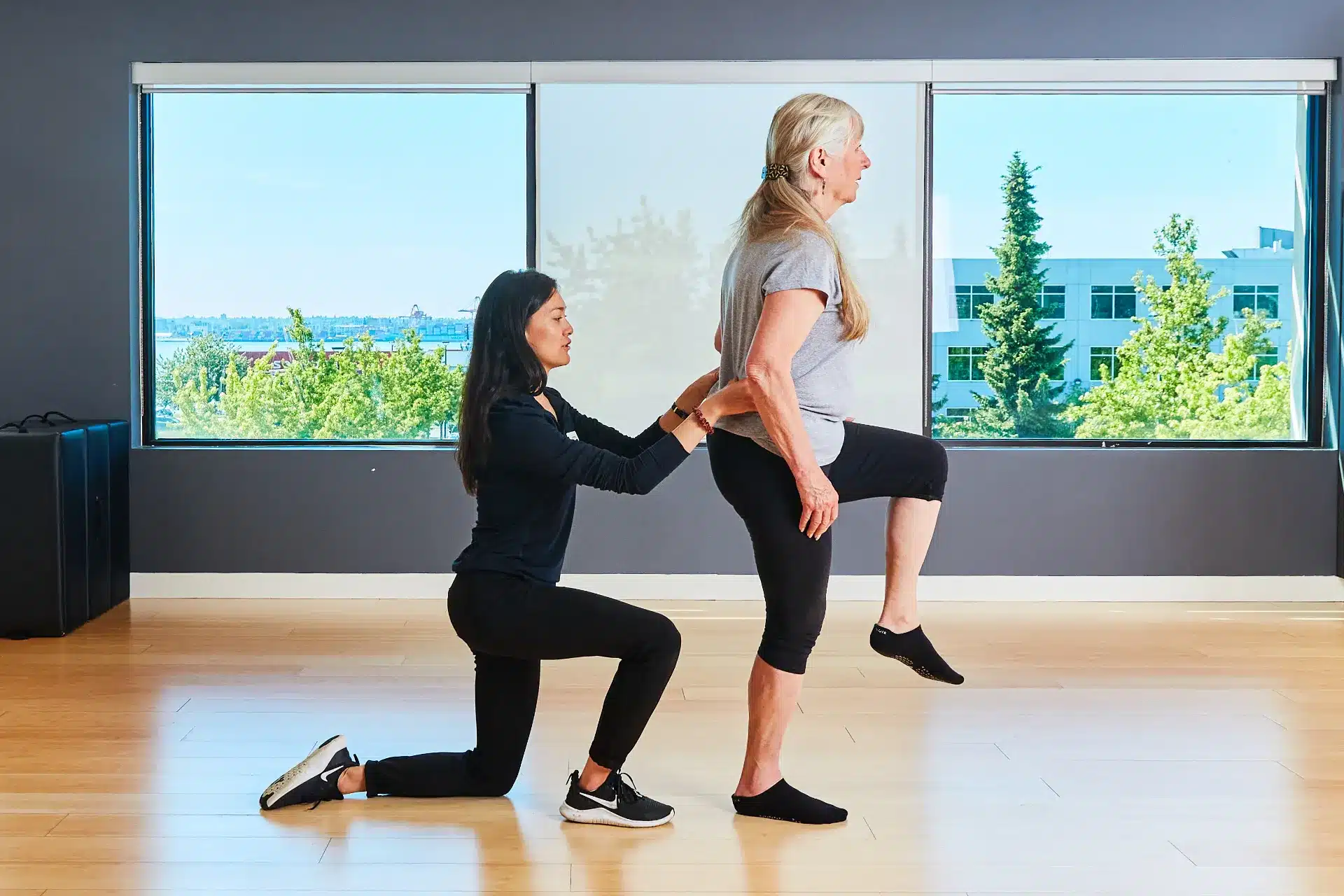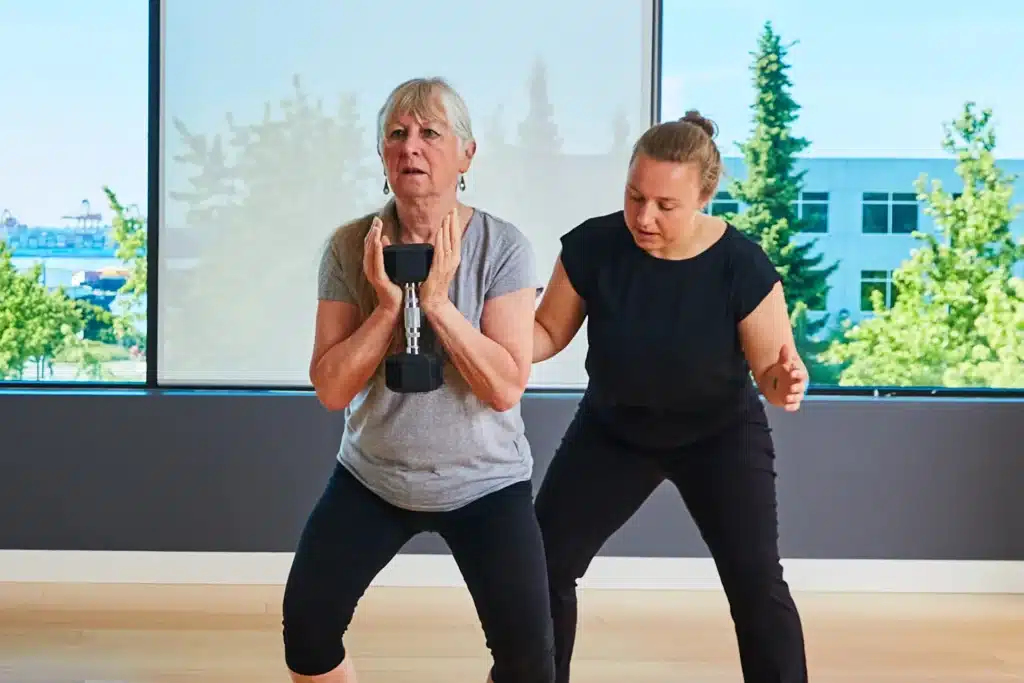
Accidental falls pose a huge health risk to all people and these injuries are often some of the worst we see in the clinic over any given year.
Not surprisingly, older adults are the most at risk for falls and the consequence of a fall in an older adult can be very debilitating, life-changing and even fatal. We decided to write this piece on falls prevention due to the winter season being upon us and because the frost and ice can make for slippery conditions that can take down even the most athletic and agile of individuals.
Are you worried about an accidental fall? It’s a legitimate concern for both young and old alike, as falls can be life-changing or even fatal. That’s why we’ve put together this blog post on fall prevention tips and risk factors to help keep you safe. Here are the four primary areas that will be covered:
- Risk factors your physiotherapist can help with
- Risk factors your family doctor can help with
- Risk factors your optometrist can help with
- Risk factors around your own home
So read on if you want to learn how to stay safe from any potential slips, trips or falls!
1. Risk factors that your Trimetrics therapists will help with
At Trimetrics Physiotherapy, Clinical Pilates and Complementary Health, we understand how important it is to stay active and maintain balance and lower body strength in order to reduce the risk of falls.
That is why we have developed our Fall Prevention Pillar Training series, an effective way to strengthen and improve one’s balance.
Our Fall Prevention Pillar Training series focuses on using isometric exercises and progresses each individual through the program to build their strength without relying on stability tools.
Our Fall Prevention Pillar Training series has been used for a variety of individuals—from elite athletes to post-operative total hip and knee replacement patients—and can help anyone looking for a comprehensive fall prevention program. Here are some of the great benefits that you can expect from doing our Pillar Training series:
- Improved balance – Strengthening your core muscles will help you maintain good posture which can lead to improved balance.
- Lower Risk of Injury – By improving your core strength and stability, you reduce your risk of injury from falls or slips.
- Increased Strength – The exercises in our training series can help increase strength in your lower body muscles, which makes everyday activities easier and less tiring.
- Reduced Stress Levels – Exercising regularly helps reduce stress levels by increasing endorphins that make us feel better overall.
- Improved Mobility – Increasing mobility through strengthening exercises can make it easier for you to move around without pain or discomfort.
At Trimetrics, we care deeply about the well-being of our clients, which is why we developed the Pillar Training series with the goal of helping individuals enhance their balance, prevent injuries, increase strength and mobility, as well as reduce stress levels. We believe that doing these exercises regularly can make a positive impact not only on physical health but also mental wellbeing.

2. Risk factors that your family doctor will help with
As we age, our risk of falls increases significantly due to a variety of factors.
From frailty and decreased sensation in the feet to polypharmacy, vitamin D deficiency and co-morbidities such as osteoarthritis or rheumatoid arthritis, it’s important for us to take steps to reduce our fall risk. That’s why we should all be working with our family doctor and other healthcare professionals like physiotherapists or naturopaths who can help us identify these risks and create plans that suit our individual needs. Here are some key things you need to know about reducing your fall risk:
- Frailty – Understand how muscle mass loss affects strength and balance
- Decreased Sensation – Identify any issues with nerve functioning in the legs/feet
- Polypharmacy – Ensure your doctor is aware of all medications taken
- Vitamin D Deficiency – Check if this could be an issue for you
- Co-Morbidities – Consider how conditions like arthritis impact stability With the right information, support from medical professionals, and a tailored plan of action – you can reduce your chances of falling.

3. Risk factors that your optometrist or ophthalmologist will help with:
Optometrists and ophthalmologists are well-equipped to help reduce the risk of falls that are due to vision problems. By seeing an eye care professional regularly, patients can receive the best treatment and advice available to keep their vision in its optimal state.
Here are some ways that optometrists and ophthalmologists can help reduce the risk of falls:
- Assess visual function such as acuity, depth perception, contrast sensitivity, and other factors associated with increased fall risk.
- Provide appropriate treatment for conditions like cataracts or diabetic retinopathy which can cause visual impairments and increase the risk of falls.
- Advise on the most suitable lenses for each individual patient, including multifocal lenses which may not be recommended for those with vertigo or other conditions.
- Offer home-based exercises that target strength and balance tailored to individuals with visual impairments which may further reduce the risk of falls.
Regularly seeing an optometrist or ophthalmologist is an important step towards reducing the risk of falls in older adults and improving overall quality of life. With their expertise in vision assessment and correction, eye care professionals will be able to provide patients with personalized treatments that meet their individual needs while helping them stay safe against potential risks.

4. Risk factors to consider around your home
It’s also important to be aware of the risks for falls within your own four walls.
Knowing what factors may contribute to an increased risk for falls, and how you can address them, is essential for keeping yourself safe.
Here are some common risk factors to look out for in your home:
- Slippery Flooring or Rugs -Floors that don’t have enough traction, or rugs that move or slip when stepped on, can cause a person to lose their balance and trip. To reduce this risk, make sure all flooring is non-slip, properly fixed down and well maintained. Any area rugs should also be firmly attached with double-sided tape or rubber stoppers.
- Poor Lighting – Poor lighting can make it difficult to see obstacles in your path, leading to trips and falls. Try adding brighter lights near doorways or walkways, or install motion sensor lights outside entrances. You should replace any burned out bulbs promptly too.
- Unstable Furniture – When furniture isn’t stable or securely fastened in place, it can easily be knocked over if bumped into, creating potential hazards like broken items or missed steps due to the sudden shift in space. Make sure furniture is safely anchored into wall studs rather than drywall anchors alone if possible; alternatively you could use corner brackets or straps designed specifically for anchoring furniture against walls more securely.
- Blocked Walkways – Cluttered pathways create an obstacle course which increases the risk of stumbling over something unseen – even if it’s just a pile of clothes left lying on the floor! To prevent this from happening, keep walkways clear at all times and store items away neatly in cupboards when not in use instead of leaving them lying around on the floor.
By taking these precautions now and being aware of these risks in your own home environment, you’ll be able to stay safe from slips, trips and falls – meaning you can enjoy greater independence now and into the future!
By understanding the potential risks in your home environment and taking steps to address them, you can help keep yourself safe from slips, trips and falls. From adding brighter lights near doorways or walkways to making sure furniture is securely fastened into wall studs, there are many ways you can reduce risk factors around your home. So take a few moments now to think about how you might be able to make changes that will ensure greater safety for yourself today and in the future.
If you need any further advice on this topic please don’t hesitate to get in touch with us – we’re here to support!

